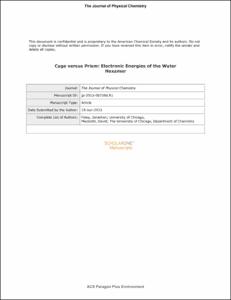Please use this identifier to cite or link to this item:
http://hdl.handle.net/20.500.12164/125Full metadata record
| DC Field | Value | Language |
|---|---|---|
| dc.contributor.author | Foley, Jonathan J., IV | - |
| dc.contributor.author | Mazziotti, David | - |
| dc.date.accessioned | 2018-10-11T20:34:58Z | - |
| dc.date.available | 2018-10-11T20:34:58Z | - |
| dc.date.issued | 2013 | - |
| dc.identifier.citation | Foley, J. J., Mazziotti, D. A. (2013). Cage versus Prism: Electronic Energies of the Water Hexamer. The Journal of Physical Chemistry A, 117(30), 6712-6716. http://dx.doi.org/10.1021/jp405739d | en_US |
| dc.identifier.issn | 1520-5215 | - |
| dc.identifier.uri | http://doi.org/10.1021/jp405739d | - |
| dc.identifier.uri | http://hdl.handle.net/20.500.12164/125 | - |
| dc.description | This document is the Accepted Manuscript version of a Published Work that appeared in final form in The Journal of Physical Chemistry A, copyright © 2013 American Chemical Society after peer review and technical editing by the publisher. To access the final edited and published work see http://doi.org/10.1021/jp405739d. | en_US |
| dc.description.abstract | Recent experiments show that the cage isomer of the water hexamer is lower in energy than the prism isomer near 0 K, and yet state-of-the-art electronic structure calculations predict the prism to be lower in energy than the cage at 0 K. Here we study the relative energies of the water hexamers from the parametric 2-electron reduced-density-matrix (2-RDM) method in which the 2-RDM rather than the wavefunction is the basic variable of the calculations. In agreement with experiment and in contrast with traditional wavefunction methods, the 2-RDM calculations predict the cage to be more stable than the prism after vibrational zero-point correction. Multiple configurations from the hydrogen bonding are captured by the method. More generally, the results are consistent with our previous 2-RDM applications in that they reveal how multireference correlation in molecular systems is important for resolving small energy differences from hydrogen bonding as well as other types of intermolecular forces, even in systems that are not conventionally considered strongly correlated. | en_US |
| dc.description.sponsorship | D.A.M. gratefully acknowledges the NSF under Grant No. CHE-1152425, the ARO under Grant No. W91 INF-1 1-504 1-0085, the Keck Foundation, and Microsoft Corporation for their support. | en_US |
| dc.language.iso | en_US | en_US |
| dc.publisher | American Chemical Society | en_US |
| dc.relation.ispartof | Journal of Physical Chemistry A | en_US |
| dc.rights | © 2013 American Chemical Society | en_US |
| dc.rights.uri | http://rightsstatements.org/vocab/InC/1.0/ | en_US |
| dc.subject | Chemistry | en_US |
| dc.subject.lcsh | Chemistry--Experiments | en_US |
| dc.subject.lcsh | Water | en_US |
| dc.title | Cage versus Prism: Electronic Energies of the Water Hexamer | en_US |
| dc.type | preprint | en_US |
| dc.description.version | Accepted Manuscript (AM) | en_US |
| Appears in Collections: | Chemistry | |
Files in This Item:
| File | Description | Size | Format | |
|---|---|---|---|---|
| jp405739d.pdf | Accepted Manuscript | 310.84 kB | Adobe PDF |  View/Open |
Items in DSpace are protected by copyright, with all rights reserved, unless otherwise indicated.
